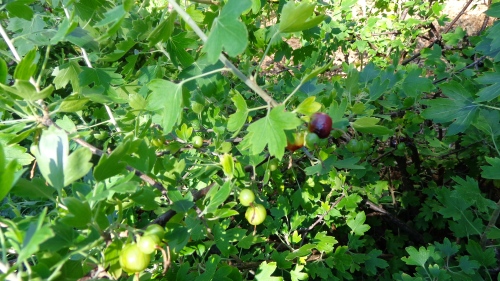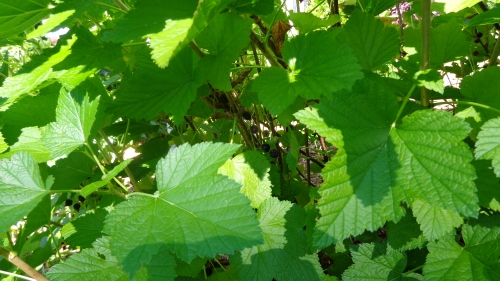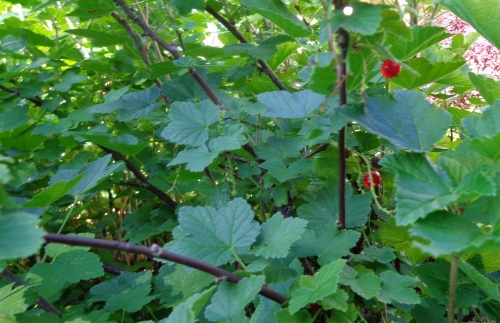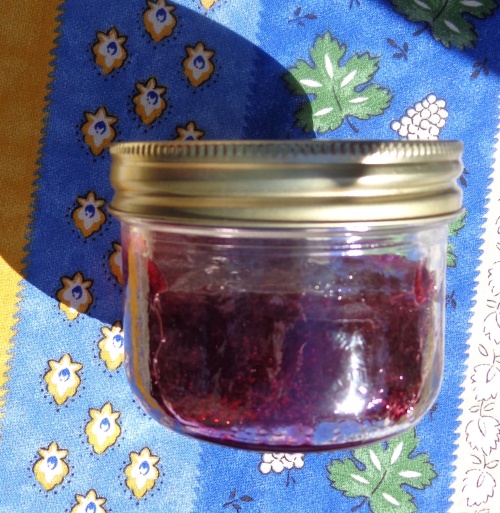One of the great joys of summer for me is canning. My kitchen is always busy in July and August (and even into September), so I thought this year, we could talk about some of my experiments. I’m always tweaking an old recipe or trying a new one.
This month, I made currant jelly. I’ve had currant bushes for a long time, and we even moved the bushes from Toronto to this house. In Toronto, the birds didn’t care about the currants and I picked them each year. Here, I couldn’t figure out why there was no fruit. I’d go out one day and there would be currants ripening as well as green ones. I’d go out the next day and it would be the same. It took me a few days to realize that there were fewer and fewer green berries—and catching Mrs. Cardinal hiding in the middle of one bush—to realize that the birds were eating them all as they ripened. We had a bumper crop this year, though, and even Mrs. Cardinal couldn’t eat them all. I picked about 5 cups of currants and made jelly.
One interesting thing is that I realized I had three kinds of currants instead of two. I knew there were black currant bushes and red currant bushes – I thought two of each, but actually there are two different kinds of black currants out there.
 The first one makes the biggest fruit and ripens last. The leaf is more frilly and the currants look like gooseberries before ripening. This kind also has a long tail on the berry from the flower, which is hard to remove without wrecking the berry. You can see some of the unripened fruit in this picture and one currant that’s half ripe—it’ll be black when it’s ready.
The first one makes the biggest fruit and ripens last. The leaf is more frilly and the currants look like gooseberries before ripening. This kind also has a long tail on the berry from the flower, which is hard to remove without wrecking the berry. You can see some of the unripened fruit in this picture and one currant that’s half ripe—it’ll be black when it’s ready.
 The other black currant has smaller fruit and ripens sooner. There are a couple of stray berries down in the middle of the photo. The leaf is very similar to that of the red currant and that combined with Mrs. Cardinal’s preference for its fruit is why I didn’t realize it was even a black currant, let alone a second kind. There’s almost no fruit left on this one as it ripens earlier, but notice how similar the leaf is to the red currant below. It is a brighter shade of green.
The other black currant has smaller fruit and ripens sooner. There are a couple of stray berries down in the middle of the photo. The leaf is very similar to that of the red currant and that combined with Mrs. Cardinal’s preference for its fruit is why I didn’t realize it was even a black currant, let alone a second kind. There’s almost no fruit left on this one as it ripens earlier, but notice how similar the leaf is to the red currant below. It is a brighter shade of green.
 The red currant has fruit that looks almost like glass beads. These are pretty much done. There should be a stem of up to two dozen berries, but the stems on mine are usually bare—like that one on the right with just one berry!
The red currant has fruit that looks almost like glass beads. These are pretty much done. There should be a stem of up to two dozen berries, but the stems on mine are usually bare—like that one on the right with just one berry!
I ended up with about five cups of berries, probably 40% black currants and 60% red ones. This is the balance suggested by this recipe so luck was with me, despite the mosquito bites.
I usually use commercial pectin when I make jam or jelly, but have a love/hate relationship with it. On the one hand, I like knowing that the jam or jelly will set. On the other, their recipes tend to require a lot of sugar and the result can be too sweet. Also, I know that people like my grandmother never used commercial pectin, so have been trying to learn how to make jam without it. I’ve tried lemon juice without a lot of success. My neighbor used to make her own crabapple juice from the fruit on the tree in her yard, then put a cup of that into each batch of jam or jelly. Liana Krissoff in Canning for a New Generation (a book I like a lot) uses sour apples to add pectin. That sounded similar to my neighbor’s solution, so I gave it a try this time.
I also didn’t want to make jam, as currants have lots of little seeds—they’re even worse than raspberry seeds for sticking in your teeth—so I mashed the fruit, added a half a cup of water, and set it to simmer. I peeled and cored two Granny Smith apples and added that to the mixture. Although the mash had to be strained and theoretically I could have left the skins and cores, there can be a lot of pesticides in the skin of fruit like apples, and I didn’t want that in my jelly. I never eat the skins so don’t cook with them either.
Once upon a time, I improvised a jelly bag by lining my sieve with a linen tea towel, then dumping the mash into it. I pulled up the corners and secured it all with an elastic band—like the kind you get on broccoli and inevitably save—then squished out the juice. This system worked well enough that I’ve kept using it. You’re not supposed to press the mash too much as all the books say it will make your jelly cloudy, but I mash the heck out of it to get every drop of juice. The leftover fruit mash from inside the tea towel goes immediately into the compost, because the fruit flies adore it and they’ll fill the kitchen in nothing flat.
I had two cups of very purple juice (and some happy fruit flies out in the composter).
This recipe, which is admittedly for jam not jelly, uses 2 cups of sugar for 490g of puree, plus the juice of half a lemon. There was 460g of juice, so I used 2 cups of sugar. Just to make sure it set, I used juice from the whole lemon. I followed these cooking directions, bringing it to a boil, then keeping it at a rolling boil for 8 minutes. Halfway through, I knew the jelly would set because it started to look like boiling burgundy glass.
 I can all my jams and jellies, even though people say you can just pour it into sterilized jars and leave it overnight. The hot jelly went into the jars, then spent 15 minutes in a boiling water bath. The lids popped right away. Is there a more satisfying sound? I don’t think so.
I can all my jams and jellies, even though people say you can just pour it into sterilized jars and leave it overnight. The hot jelly went into the jars, then spent 15 minutes in a boiling water bath. The lids popped right away. Is there a more satisfying sound? I don’t think so.
There were not quite 3 pints of jelly—this is the jar that wasn’t quite as full, and we’ll use it first. I’ll use the jelly to glaze fruit tarts—and that only takes 1/4 cup each time, so we have plenty. The color is fabulous and it tasted great (I licked all the spoons) plus it set beautifully!

Awesome I used to make wild grape jelly with my MeMaw !
XOXO Eliza
LikeLike
I love your cooking/canning segments Deb. I am a veggie canner, last year I made my own marinara for the first time, best ever! I can tomatoes and make pickles with green tomatoes and with cucumbers, put up corn, green beans and sometimes if I have a bumper crop I freeze green peppers too. Thanks for sharing it looks yummy!
LikeLike
Your marinara sauce sounds great, Deb!
LikeLike